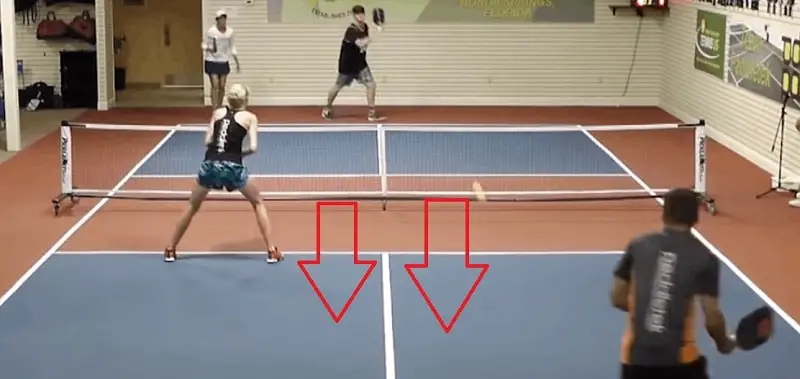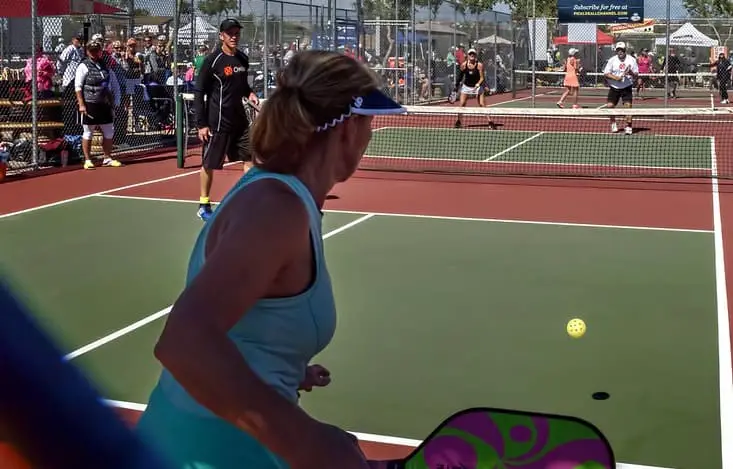As we grow deeper into learning the nuances of the sport of pickleball, it’s important to not only understand some of the terms associated with it but also how to actually use that knowledge to get the better of your opponent. And in this piece, we look at what is the no-man’s land in pickleball and tips to get better while one is there.
Pickleball is often compared with sports like tennis, table tennis and badminton but the one aspect of this game that makes it different from the rest of the racket sports is the non-volley zone or the kitchen.
And while there are many a tips associated with how to use pickleball’s kitchen, we will look to understand here the region on a pickleball court that’s called the no-man’s land and how to improve one’s play there.
Let’s start with the basics first.
Table of Content
What’s the No-Man’s Land in Pickleball?
The term, no-man’s land in pickleball is actually borrowed from tennis and is used to describe the area on the court between the baseline and the non-volley zone or the kitchen.
The No-Man’s Land is also called the Transition Area in pickleball and can be counted as the rectangular box formed from joining the imaginary lines a couple of feet behind the kitchen and in front of the baseline and the sidelines on the court.

In the above picture, the area pointed to by the arrows denotes the No-Man’s Land in pickleball.
Also Read:
Why Is It Called the No-Man’s Land?
According to Merriam-Webster, one of No-Man’s Land’s definition is ‘an area not suitable or used for occupation or habitation‘. Well, that’s closely related to pickleball too.
The reason why the No-Man’s Land is called so is because it’s the area on the court which players tend to avoid to get caught at since it is rather tough to earn them points there.
It’s an area where the opponents can get you to hit the pickleball low at your feet, making you bend to return the shot and in turn causing a lot of difficulties.
Since players need to really bend low to try and return these shots, it allows the pickleball to stand up for the opponent to be hit and put away for points.
Don’t take our word for it though!
Try to practice a few drills at the No-Man’s Land and very soon you would realize how difficult it is to win points from that position, which is also why the absolute importance to get away from there.
As mentioned earlier, this No-Man’s Land in pickleball is also called the Transition Area and here’s why.
Why is Pickleball’s No-Man’s Land Also Called the Transition Area?
The No-Man’s Land is a place on the pickleball court which players need to desperately avoid because statistically speaking it’s the least favorable area on the court for winning points for a player or a team.
This is also why players avoid it like a rash and more so after they have made or returned the serve.
The chances of winning a point go up greatly at the edge of the kitchen, forcing players to make that transition from the baseline to the Non-Volley Zone as quickly as they can.
This is also why this region on the pickleball court is called the Transition Area, one where the players make that transition from the baseline to the Non-Volley Zone.
So Why is it Important to Play Well in the No-Man’s Land?
All the talk in this piece, so far, has been about the necessity to avoid the No-Man’s Land, obviously as the name suggests as well. And despite that, it is important for players to do a good job in the No-Man’s Land.
This is because despite all one’s efforts, there will be times during a match it would be inevitable for the player(s) to become a part of that zone.
The No-Man’s Land cannot always be avoided by players especially after hitting the third shot drop when a player will have need to get through that area to get close to the Non Volley Zone.
And in that case, the team or player who is better at dealing with a point while being in No-Man’s Land would have a better chance of winning the match. This is also why it is important to practice becoming a better player in this Transition Area of pickleball.
Also Read:
How to Improve One’s Play in Pickleball’s No-Man’s Land?
Now that we have learnt more about what is the No-Man’s Land, the importance to keep away from it but at the same time the need to become better while playing from that area on the court, it’s time to look at how one can improve one’s game in the No-Man’s Land.
Move in at a Slower Speed
It’s very important to remain in control of the point while moving in from the baseline to the pickleball kitchen, and the way to do that is to move in slowly, and more calmly.
It might be tempting to get in quicker in a haste to get to the Non-Volley Zone but that comes with its own issues, which is why being in control is far more important even if one hasn’t reached the kitchen.
Many players, in a bid to get to the kitchen more quickly end up with the kind of momentum that ends up stalling the ball.
Keep the Paddle in the Right Position
While it is quite normal to be caught in the No-Man’s Land during a point in pickleball, it is imperative one is not caught with the paddles down!
To put it more simply, ensure your paddle is above your waist, in front of you and in a position from where you are ready to play either the back-hand or a forehand.
The angle at which you keep the paddle while returning the low shot is important as well. It should be angled and facing the sky, not parallel to either the net or the ground to ensure the ball goes back over the net.
Also ensure not to try and counter an aggressive shot at your feet with another aggressive shot – the task here is to ensure the pickleball is sent back over the net rather than score a winner at this stage.
Do this by keeping a loose grip on your pickleball paddle. A tighter grip will allow the ball to sit up to be smashed away for a winner by the opponent.
Aim to Hit from Above the Knees
One of the reasons why the No-Man’s Land is a tough place to play from is most of the shots that come at the players caught there are at their feet.
One way to counter that is to ensure you move at a consistent speed which allows you to change your speed depending on where the pickleball’s headed such that you can try and hit it from over your knee.
Higher the position of the ball while you are in the No-Man’s Land, easier it gets to get it back to your opponent without the risk of getting smashed away for a winner.
Remain Low While Making the Transition
Given we have already established your opponent will try to hit the ball at your feet while you are in the No-Man’s Land, one effective way of being ready for it is to remain low while returning it.
While you are low, with the feet slightly wide, it gives you the stability with which a shot hit at your feet can be returned without causing as many issues as otherwise.
Practice No-Man’s Land Drills
There are quite a few drills associated with the No-Man’s Land, and it is very important for pickleball players to keep repeating those in order to get used to becoming as good as one can while making that transition from the baseline to the kitchen.
One of these drills has one player standing at the kitchen and the other in the No-Man’s Land. The objective for the player at the No-Man’s Land is to drop each shot into the Non-Volley Zone, while the other player should look at getting the shot away to his opponent’s foot.
In doing so, the player at the kitchen needs to look to win the point, or making it as difficult as it is feasible for his opponent.
Final Words on the No-Man’s Land in Pickleball
While the No-Man’s Land or the Transition Zone in pickleball is a difficult place to be, it is also inevitable one has to go through it to get to the kitchen. In doing so, it is imperative for the players to give oneself the best chance of remaining in the point and even scoring a win.
By using the tactics mentioned above, you can make it a lot easier for you even while making that transition from the baseline to the kitchen.


